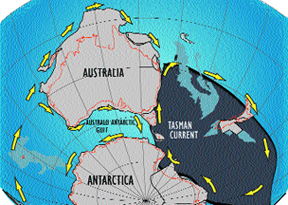 Imagining
an Antarctica with trees and ferns — and without ice — may be difficult,
but about 35 million years ago, as the supercontinent Pangea was breaking up,
the now-frozen polar continent had a much more temperate climate. What exactly
caused its shift to a deep freeze has long puzzled paleoclimatologists. New
data and models — implicating carbon dioxide in the atmosphere — are
challenging the idea that tectonics were to blame.
Imagining
an Antarctica with trees and ferns — and without ice — may be difficult,
but about 35 million years ago, as the supercontinent Pangea was breaking up,
the now-frozen polar continent had a much more temperate climate. What exactly
caused its shift to a deep freeze has long puzzled paleoclimatologists. New
data and models — implicating carbon dioxide in the atmosphere — are
challenging the idea that tectonics were to blame. Even though Antarctica was at the south pole around 35 million years ago, it was warm and relatively ice free; then it abruptly froze. Early data showed that as Australia moved north and the Tasmanian Gap opened, cold counterclockwise currents replaced warm ones, isolating and chilling the continent. But new fossil data show the opposite, shown here, which may have had little effect on Antarctica’s growing ice sheets. Courtesy of Matthew Huber; modified by Mark Shaver.
During the shift from the warm Eocene to the cold Oligocene, permanent ice sheets finally established themselves on Antarctica, around 33.5 million years ago. About that time, the Tasmanian Gateway — a shallow sea that deepened and widened as Australia slowly drifted away from Antarctica — opened. Climate researchers hypothesized that the new notch in the ocean floor brought in cold currents that refrigerated the region.
James Kennett and his co-workers established that idea in 1975, using fossil evidence in cores from Deep Sea Drilling Project leg 29 in the Tasmanian region that supported a shift from warm to cold currents surrounding and isolating the Antarctic, generally flowing counterclockwise. Kennett, now at the University of California, Santa Barbara, and Neville Exon of Geoscience Australia extended the idea last December in an American Geophysical Union monograph, using past studies and new data from a more recent cruise, Ocean Drilling Program leg 189. But data from that same cruise also supports an opposite view, according to researchers who analyzed the region’s first four nearly continuous cores, covering the Eocene-Oligocene boundary.
The original hypothesis rested on microfossils with calcium-carbonate skeletons, says Catherine Stickley, a biostratigrapher at Cardiff University in the United Kingdom, not the silica-based and organic ones that are abundant throughout the new cores. Focusing on dinoflagellate cysts and diatoms (organic-walled and silica-containing microalgae), Stickley and her co-workers published a detailed assessment in the December Paleoceanography that tells a very different story.
The fossils date the gateway’s first deepening to 35.5 million years, about 2 million years before the Antarctic’s permanent glaciation. “In this instance, this is a sufficiently long time gap,” Stickley says, to lessen the linkage between the deepening and the permanent Antarctic glaciers. They also found that instead of moving from warm to cold currents, a cold clockwise current was characteristic of the region. And by the time the gateway finished deepening around 30.2 million years ago, a warm clockwise current had moved into the region from the subtropics, after the continent-wide ice was established.
As reported in a companion paper by a team led by Matthew Huber of Purdue University, a co-author on Stickley and colleagues’ paper, models show that early warm currents in the region did not keep the continent warm, as they were flowing in the wrong direction. The deepening of the gateway and timing of glaciation was coincidental, they hypothesize. Instead, they say, a serendipitous combination of the planet’s orbital cycles, where seasons remained cool enough to maintain ice at the pole year-round, and changes in greenhouse gases in the atmosphere seem to have collaborated to cool the region and promote the growth of the Antarctic ice sheet.
The idea that atmospheric carbon could be the culprit was first put forward several years ago, most notably in a model by Rob DeConto of the University of Massachusetts, Amherst, and Dave Pollard of Pennsylvania State University, in 2003. Although Huber’s team’s new model focuses on oceans, and DeConto and Pollard’s on ice, “we’re converging on the same conclusion,” DeConto says. “The opening of the southern ocean gateways seem not to have had … as big an effect on Antarctica.” Although the deepening could have been a trigger, glaciation probably would have happened anyway, he says.
Kennett says that the microfossil data do not agree with Huber and colleagues’ model. Kennett notes that some of the open-ocean microfossils and closer-to-shore assemblages indicate different water temperatures. “The opening and closing of gateways has an effect,” he says.
“People often believe that, intuitively, if you have an extreme and rapid change, there must be a rapid forcing,” says Paul Wilson of the Southampton Oceanography Centre, in the United Kingdom, but more gradual changes can also bring systems to the brink. Wilson, who favors the carbon-loaded atmosphere as the agent of change at a time when Earth’s orbit was just right, says that determining the cause of the “switching point” in ancient Antarctica, from small or nonexistent ice sheets to a continent-wide glacier, may have important implications for carbon-loading in today’s Antarctic atmosphere.

